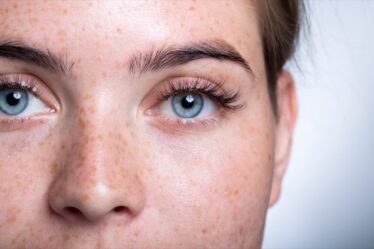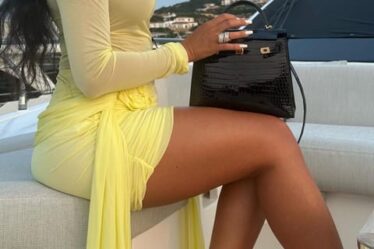Lacoste may be French-born, but the US has long been a part of its story: it was an American journalist who, in the 1920s, nicknamed 19-year-old tennis player René Lacoste “the Crocodile,” that would become the well-known emblem of his eponymous brand.
Nearly 100 years later, Lacoste is once again looking to the US, the world’s biggest sportswear market: on Thursday, the brand will officially open its new 10,000-square-foot flagship on New York’s Fifth Avenue. Surrounded by hot dog carts and a constant flow of yellow cabs, the new store, which sits between Adidas and Hoka, is meant to be a show of Lacoste’s progress — in making the sportswear label more fashion-centric and revamping key categories like fragrance and accessories — and a show of its ambitions.

“It feels like coming home,” said creative director Pelagia Kolotouros from the airport in Paris. Kolotourous, a New York City native who previously worked at Adidas, Beyonce’s Ivy Park and VF Corp-owned North Face, was named creative director in 2023. “There’s always a juxtaposition in what I do for Lacoste, playing off these two personalities of somebody that’s elegant, and somebody who’s gritty. That comes from my upbringing in New York.”
It’s also a key element of Lacoste’s plans to double sales in the US, currently $450 million annually, in order to reach €4 billion ($4.38 billion) in total revenue between 2028 and 2030. (Last year, sales grew 8 percent to €3 billion.)
Beyond the New York opening, to achieve that goal, Lacoste has been building fashion credibility on the runway with more clear-eyed showcases featuring lush fabrics, breezy suiting, witty sweaters and an increasingly star-studded front row, as well as expanding its retail presence, opening flagships in Paris in 2022 and London in 2023.
But to grow, Lacoste, which is owned by Swiss holding group Maus Fréres, faces several hurdles. Increasing economic uncertainty in the US has the potential to derail its plans if consumer appetite to spend slows. At the same time, as more brands pile into sport, Lacoste will have to defend its heritage tennis and golf positioning.
“We will still push in the US because the potential is huge in the US … We can easily double the business, even if the market is not in good shape,” said CEO Thierry Guibert. “My concern is to keep on raising the brand, investing in the brand and taking market share.”
Finding its Footing
Before Lacoste entered its bulking phase — it first had to cut.
After years of wholesale overexposure, the brand cleaned up its distribution, moving to a 70 percent direct-to-consumer, 30 percent wholesale mix.

To unify the look, it bought back its underwear, shoe and accessories licenses, and sold its fragrance license to Interparfums, after years of working with Coty. Today those categories are Lacoste’s main growth levers, said Guibert. Lacoste relaunched its Original Eau de Parfum late last year, which helped drive a 10 percent rise in profit year-over-year in 2024 for Interparfums. It released an underwear campaign with American actor Taylor Zakhar Perez in January; and dropped a new shoe, the L003 Neo Shot sneaker, in February.
The brand also strengthened its leather goods offer with items such as its $225 Lenglen handbag, which imitates the pleats of a tennis skirt, as well as the Racket Bag, a shoulder bag that mimics the shape and an embossed crocodile tote. A weekender bag, plus footwear that melds fashion and sport, including a sneaker-high-heel amalgamation and a pair of flat, slipper shoes with rubber spikes, are set to drop later this year.
The Lenglen featured on its buzziest runway yet: Fall/Winter 2025, held on the clay court of Roland-Garros, with Adrien Brody, Claire Danes and Venus Williams in attendance. (In another sign its cultural relevance is on the rise, fans of the rapper Doechii have been calling for a collab between the two after the release of her “Alligator Bites Never Heal” album.)
Previously, there was a disconnect between what Lacoste showed on the runway and its standard product mix; former designer Louise Trotter, who left the brand in early 2023, made progress on that front, and under Kolotouros, the label is “building bridges” between the two, she said. Sometimes the bridges are literal, such as with the Lenglen; other times, they’re more abstract, such as with the cuts, fits or theme.
This season, Lacoste produced more looks from the runway than ever. The range of $590 dresses, $190 polos and $490 wool shorts (pricey compared to the rest of Lacoste’s mix, but competitive in the contemporary landscape) take up half of the flagship’s ground floor; while its signature polos float in the front window and the entrance.
The brand — whose largest wholesale partners include Macy’s and Nordstrom — is also trickling into more fashion-first retailers like Ssense. Still, its accessible positioning is a strength in today’s market, Guibert said, and maintaining wholesale and department store channels is key to staying reachable.
“Luxury brands are struggling for many reasons. There are new consumers, especially in Asia, but also in America that are looking for a premium quality brand but don’t want to pay crazy prices,” said Guibert. “They’re looking for a balance between good quality for money.”
Designing for Lacoste’s broad range of consumers and price ranges is natural, said Kolotouros: “It’s how everybody dresses. You might want to wear Levi’s and an expensive cashmere sweater. Having that high and low price points is important.”
Operating in a Tighter US Market and Keeping its Tennis Core
Now, Lacoste finds itself in the same place as many brands across the industry: aggressive US sales growth plans laid in January have been muddied in April.

Donald Trump’s evolving trade policies and their potential knockdown effect on consumer appetite to spend, have made the outlook in the US increasingly uncertain. While it’s early to tell, there’s the potential that could put a damper on Lacoste’s plans in the US.
“There will be an impact on consumption because there will be inflation on some product categories … There could be less growth due to the market environment,” said Guibert.
Still, being relatively small compared with sportswear giants like Nike and Adidas is a competitive advantage, Guibert argues. It gives the brand room to grow — by opening stores, expanding to new territories (California and Texas have yet to reach their full potential, he said) and into underdeveloped product categories. With its premium price point, the brand isn’t focused on volumes, he said, meaning less risk should the economic environment take a turn. Plus, the opportunity to take market share — a la On and Hoka, with their specific sport positioning — is ripe.
However Lacoste will have to be extra diligent in defending its on-court dominance as more brands look to tap the tennis boom. It’s increasingly competitive to secure the right partners: in recent years, Gucci, Louis Vuitton and Hugo Boss have signed top talent Jannik Sinner, Carlos Alcaraz and Taylor Fritz, respectively. Though Lacoste overindexes on tennis heritage, counting longtime partnerships with Novak Djokovic and prestigious tournaments such as Roland Garros and the Miami Open, others, perhaps, have more fashion credibility.
“That means we have to be smarter in the future because it will be more expensive,” said Guilbert.
Content shared from www.businessoffashion.com.


